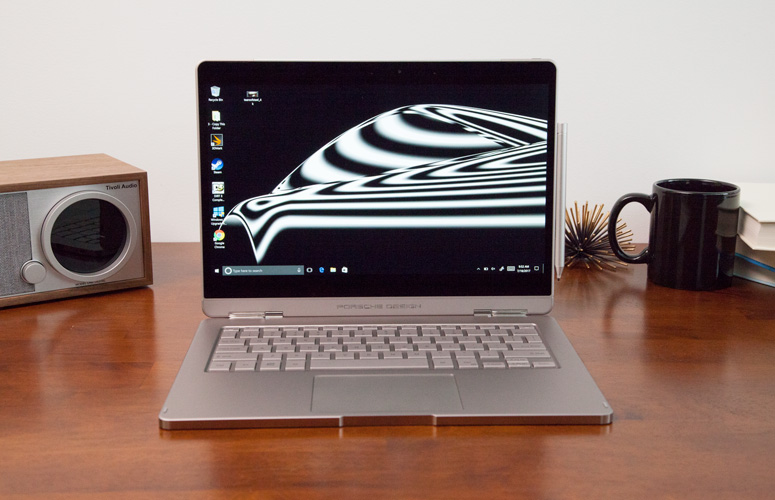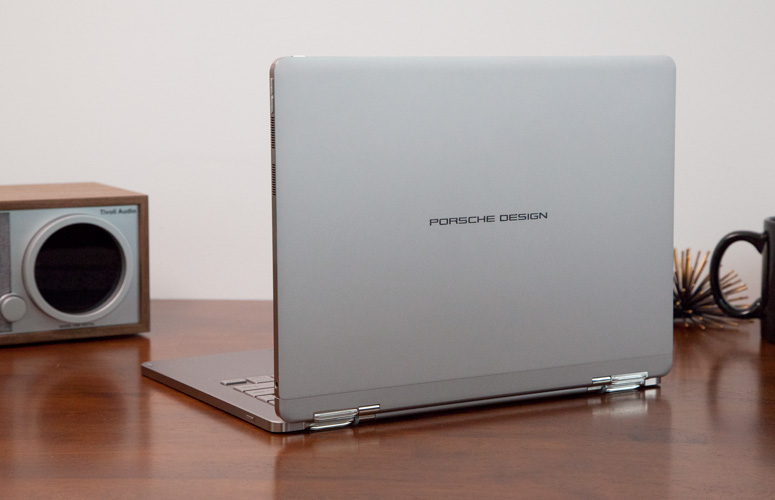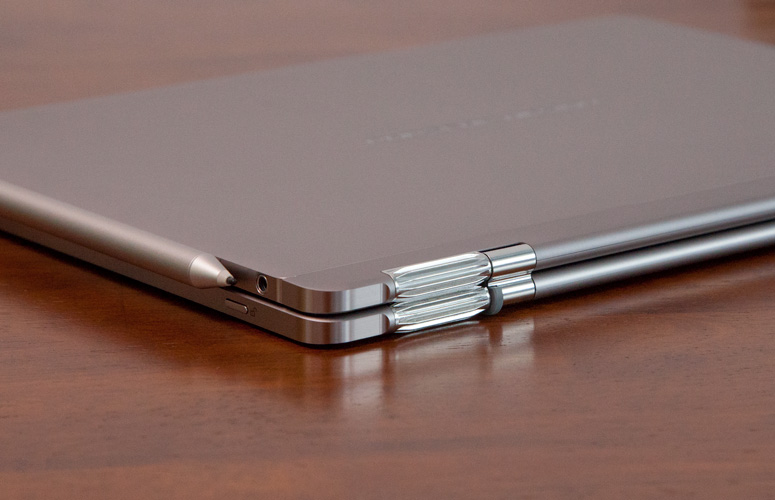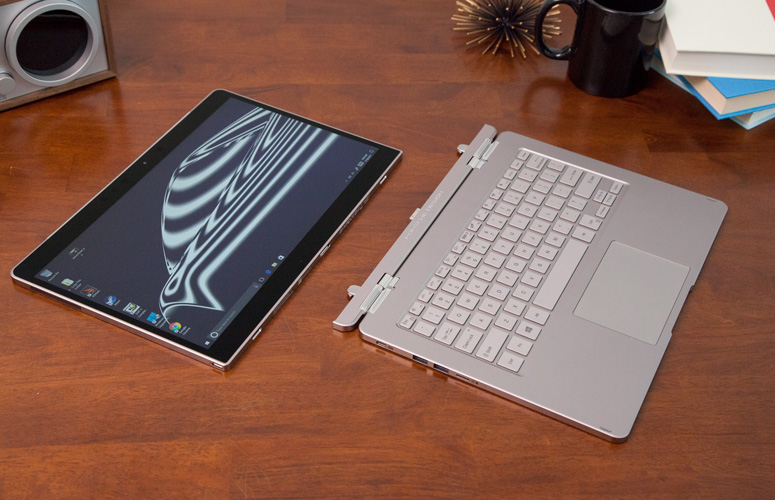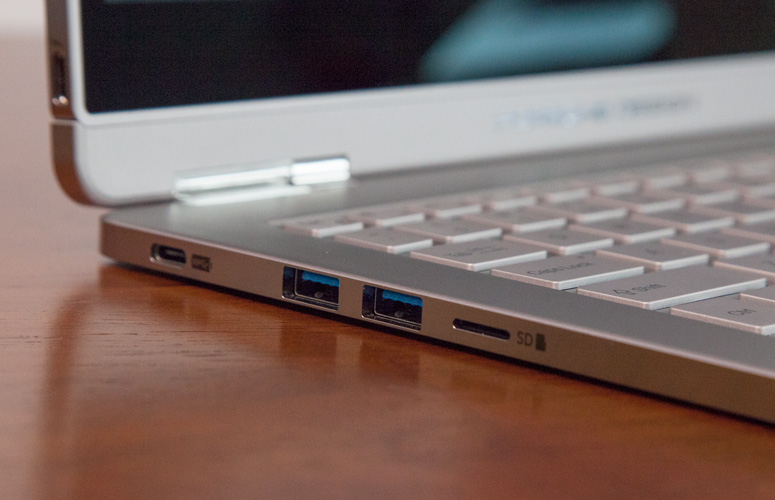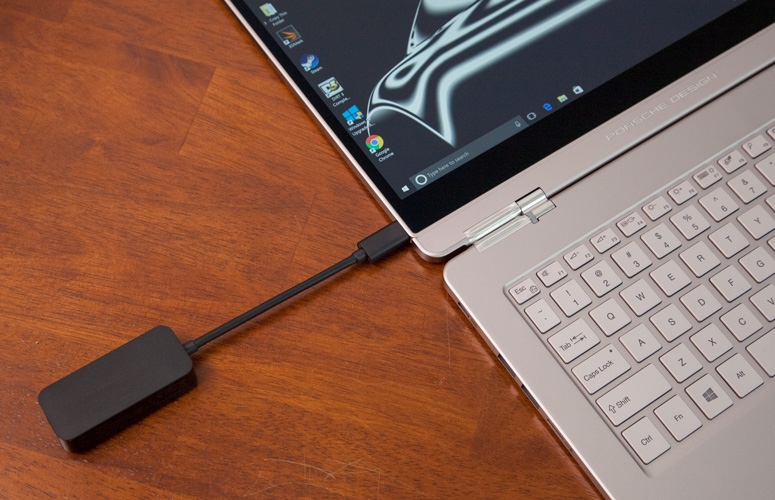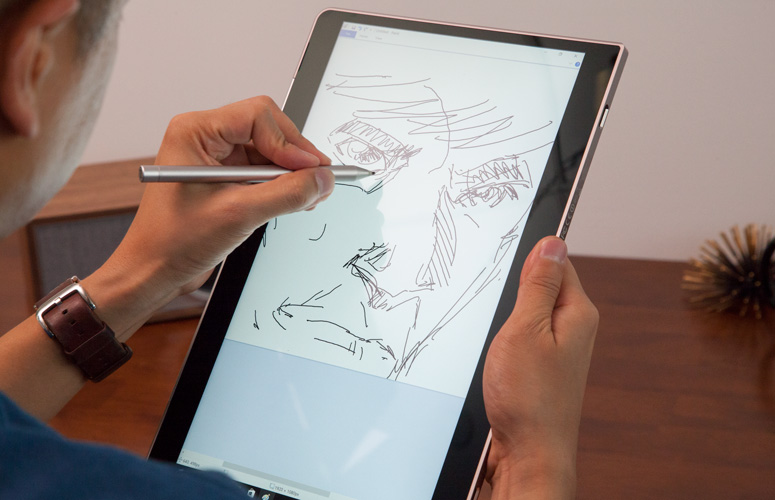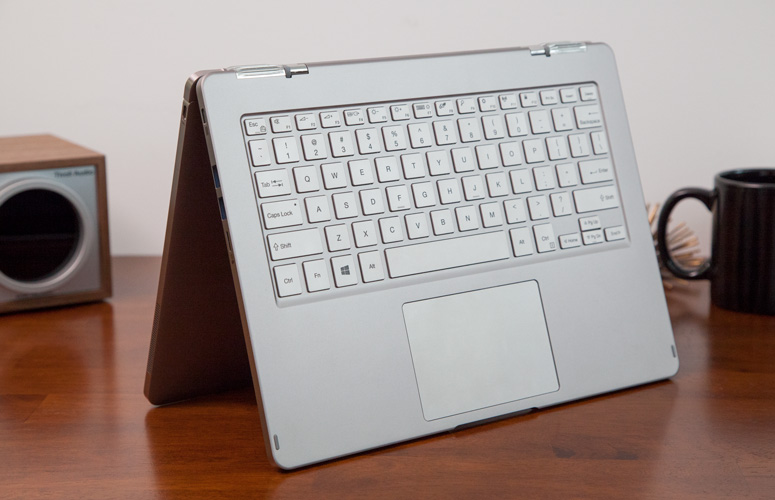Laptop Mag Verdict
The Porsche Design Book One features a glorious, innovative design that lets it serve as both a detachable and convertible 2-in-1, but competitors offer better performance and endurance.
Pros
- +
Vivid, bright display, USB Type-C and Type-A; Both convertible and detachable; Great stylus
Cons
- -
Mixed performance; Top-heavy; Stiff keyboard
Why you can trust Laptop Mag
Should you get a convertible 2-in-1 or a detachable 2-in-1? Why not both? The Porsche Design Book One ($2,495) flips all the way around, but the display is also detachable for use as a lighter slate. And, coming from Porsche Design, it has an impeccable, clean look that accentuates its function. The Book One's display is insanely bright and vivid and the stylus is comfortable to hold, but when it comes to performance and battery life, companies that have spent more time making laptops outperformed this looker.
Design
You don't pay $2,495 for a laptop from Porsche Design without one thing in mind above all else: form that accentuates function. The Book One is largely a winner in that regard. It's a laptop that not only takes being a workhorse seriously, but also innovation, as it's the first convertible 2-in-1 with a detachable display.
The matte silver aluminum lid is plain and solid, with Porsche Design's logo in the center. Opening the notebook is simple, thanks to a divot in the keyboard with more than enough room for a finger, similar to the MacBook Pro's front lip. The 13.3-inch, 3200 x 1800 IPS display is surrounded by minimal bezels on its sides, but has a thick bezel on the top to make room for the infrared camera. The island-style keyboard is the same shade of silver. There are two raised rubber stoppers on the edges of the palm rest to keep the display from crashing into the aluminum, but they're the cheapest-looking part of the design. Many other premium products have come up with other ways to protect the glass.
The most striking part of the design are the hinges, which are shaped like very long gears. These allow the display to rotate 360 degrees for use in laptop, tablet, display and tent (an upside-down "V") modes, but I didn't find them any more stable than the hinges on other 2-in-1s.
The big differentiator in the Book One's design is that detachable tablet. A press of the release button on the right side of the keyboard base reveals an unlock sign on the lower bezel, and it pops off of the hooks and four magnets with a satisfying amount of resistance. Those same magnets make it extremely easy to pop the tablet back on.
At 12.2 x 8.9 x 0.6 inches and 3.5 pounds, the Book One is heavy for a 2-in-1. Microsoft's Surface Book (12.3 x 9.1 x 0.9 inches) is 3.3 pounds and the Lenovo ThinkPad X1 Yoga (13.1 x 9 x 0.7 inches) is 3.2 pounds. The HP Spectre x360 (12 x 8.6 x 0.5 inches) is the featherweight of the group at 2.6 pounds.
Sign up to receive The Snapshot, a free special dispatch from Laptop Mag, in your inbox.
On its own, the Book One's tablet is 1.7 pounds and 12.3 x 8.2 x 0.3 inches. It has all of the computing parts in it, and I found that it made the device top-heavy when used as a laptop. Though your wrists hold it in place while typing on your lap, the device can be a bit wobbly if you don't have a hand on it. I rarely wish that computers were heavier, but a bit more heft in the base would have gone a long way.
The Book One is most like the Surface Book in that it has a detachable display, but it's stricter in how it's used. For instance, you can put the Surface Book's display on backwards, while the Book One's display only goes on forward. For the same effect, you have to flip the Book One into tablet mode, something Microsoft's laptop can't do. But that means the Book One closes flat, unlike the Surface Book and its fulcrum hinge that leave a gap between the screen and the keyboard.
Ports
The Book One's selection of ports splits the difference between the present and the future. The left side of the keyboard boasts a USB Type-C port, two USB 3.0 ports and a microSD card slot.
On the left side of the tablet, there's a Thunderbolt 3 port, and the right side of the tablet is where you'll find the headphone jack. There are no ports on the right side of the keyboard -- just the unlock button. Having this button on the side, rather than on the keyboard, like the Surface Book, lets you detach in tent or presentation mode when the keyboard isn't visible.
If you need to connect an external monitor and don't have one that supports USB-C or Thunderbolt 3 yet, you can use the included HDMI dongle.
Display
The 13.3-inch, 3200 x 1800 display on the Book One is nothing short of beautiful. It checks all of the boxes: it's vivid, it's sharp and it's bright. When I watched the 4K movie Tears of Steel, I could easily make out every shingle on every roof when a sniper overlooked a town, and the green and purple holograms in a computer lab were particularly vivid against the gray walls.
The Book One covers an amazing 135 percent of the sRGB color gamut, showing off more vibrant hues than the average ultraportable (100 percent), ThinkPad X1 Yoga (109 percent), Spectre x360 (102 percent) and Surface Book (99 percent).
This thing gets nice and bright. The Book One's display measured an average of 450 nits, far more luminous than the category average (290 nits), Surface Book (387 nits), Spectre x360 (318 nits) and ThinkPad X1 Yoga (274 nits).
Keyboard and Touchpad
A good keyboard isn't just about travel. The Book One's keyboard has our preferred minimum 1.5 millimeters of travel and a strong 70 grams of actuation, but the keys don't pop up quickly, making it stiff for touch-typists.
The keys also feel especially plastick-y against the otherwise metal construction. I still managed to type my average 107 words per minute on the 10fastfingers.com typing test, but my errors doubled from 2 percent to 4 percent.
The 4.1 x 2.7-inch touchpad is perfectly clicky, and it instantly responded to gestures like pinching to zoom, swiping three fingers down to hide windows and tapping four fingers to open the app center. It's the closest to a Mac touchpad that I've found on a PC.
Stylus
I really like the feel of the aluminum stylus. At 5.5-inches long, it has the feel of a real pen, and the one flat edge on its otherwise rounded design guides your fingers to the two buttons. Those barrel buttons are slightly different shapes, which helped me distinguish between them.
The stylus offers 4,096 points of pressure sensitivity, and I used that to my advantage when drawing in Fresh Paint. I could make a light stroke with a virtual brush, or glob paint all over the canvas by pressing just a little harder.
The Wacom Pen software lets you customize the buttons on the stylus. In Fresh Paint, I appreciated the default, which used one button as an eraser and the other to move the canvas, but you could also use it for navigating in Windows as left or right clicks.
While Microsoft's Surface Pen lets you use the back as an eraser, that wasn't the case with the Book One's stylus. In fact, the reverse end of Porsche Design's pen wrote on the display just like the tip, albeit less accurately.
The Book One's stylus attaches to the tablet magnetically, but only on the right side.
Audio
The speakers in your Porsche laptop won't have the same punch as the sound system in your Porsche car, but they're average for a notebook. When I listened to Cayucas' "High School Lover," the vocals, guitars and drums were clear, but the bass line was extremely quiet.
Performance
Armed with a 2.9-GHz Intel Core i7-7500U CPU, 16GB of RAM and a 512GB SSD, the Book One can handle multiple tasks at once. I had 30 tabs open in Chrome, including one streaming Last Week Tonight with John Oliver in 1080p, without any hint of lag. Benchmarks, though, told a slightly different story.
On the Geekbench 3 overall performance test, the Book One notched a score of 7,524, easily beating the ultraportable average (5,926) and the Surface Book (6,814, Core i5-6300U). The Spectre (7,993, Core i7-7500U) and the ThinkPad X1 Yoga (8,073, Core i5-7300U) were stronger performers.
MORE: The Best Laptops for Every Need
The Book One took 20 seconds to transfer 4.97GB of mixed-media files, a rate of 254.5 megabytes per second (MBps). That's faster than the average (215.6 MBps) and the ThinkPad X1 Yoga (169.6 Mbps). The Surface Book and the Spectre x360 were both faster with identical speeds of 318.1 MBps (see which laptops have the fastest SSDs overall).
It took 5 minutes and 18 seconds for the Book One to pair 20,000 names and addresses in our OpenOffice productivity test, which is speedier than the 6:03 average. The Spectre (3:33), ThinkPad X1 Yoga (3:35) and Surface Book (4:17) were all more than a minute faster, though.
This isn't a computer to use for heavy video editing or intense gaming. With its Intel HD Graphics 620 integrated GPU, it earned a score of 50,404 on the 3DMark Ice Storm Unlimited benchmark, below the average of 57,084 (though that includes some 13-inch gaming notebooks). The Surface Book did better at 59.957, as did the ThinkPad X1 Yoga (76,248) and Spectre (70,494).
Battery Life
The Book One will last a workday on a charge, but its competitors last a lot longer. Porsche Design's laptop endured for 8 hours and 33 minutes on the Laptop Mag Battery Test, which consists of continuous web browsing over Wi-Fi. That's better than the 8:27 average, but the Spectre (10:06), ThinkPad X1 Yoga (12:06) and Surface Book (12:29) were all longer-lasting.
MORE: Laptops with the Longest Battery Life
If you're only using the tablet, though, expect lesser battery life. Without the extra charge from the keyboard base, it lasted just 3 hours and 32 minutes on the test.
Webcam
The 1920 x 1080 webcam in the Book One takes solid, sharp photos. Even when I snapped a picture of myself in challenging conditions at my desk, with low lighting, my blue shirt came out color-accurate. I could even make out individual hairs in the resulting photo.
Heat
The Book One stayed cool in our testing. After 15 minutes of streaming HD video from YouTube, the touchpad measured 76.5 degrees Fahrenheit, the center of the keyboard reached 78.5 degrees and the back of the tablet climbed to 88 degrees. All of those measurements are below our 95-degree comfort threshold.
But during my own personal use, I found that it jumped to 95 degrees with a few Chrome tabs open and YouTube playing. It wasn't too hot to handle, but it was noticeable.
Software and Warranty
Other than the Wacom stylus software, Porsche Design didn't preload any other software on the Book One, placing it with Microsoft's own Surface computers as one of the few notebooks that don't have any bloat from the vendor.
You still, however, have to deal with the bloatware that comes in all Windows 10 laptops, including Candy Crush Soda Saga; March of Empires: War of Lords; Minecraft: Windows 10 Edition; and Twitter.
MORE: Best and Worst Laptop Brands
Porsche Design sells the Book One with a one-year manufacturer's warranty for the laptop and six months of support for the included accessories. If a customer registers their device within 30 days of purchase, they get access to a premium tier of remote support.
Bottom Line
The Porsche Design Book One has a design that turns heads, and its ability to serve as both a convertible and detachable 2-in-1 is an awesome innovation.
But when it comes to performance, laptops that opted to be just one kind of 2-in-1 had it beat. The convertible Lenovo ThinkPad X1 Yoga ($2,177 when similarly configured, but with a 1080p display), is faster and lasted 12 hours on a charge in our testing. The detachable Microsoft Surface Book ($2,499 when similarly configured) lasts longer and has a speedier SSD, but it uses an older CPU.
If using your laptop in every possible use case is your highest priority, the Book One is for you. Its superior design and more options than a Swiss army knife will work for you, and others will notice. However, if you don't need as much style, consider an alternative and get a battery and performance bonus.
Porsche Design Book One Specs
| Bluetooth | Bluetooth 4.1 |
| Brand | Porsche Design |
| CPU | 2.9-GHz Intel Core i7-7500U CPU |
| Card Slots | microSD |
| Company Website | http://www.porsche-design.com/ |
| Display Size | 13.3 |
| Graphics Card | Intel HD Graphics 620 |
| Hard Drive Size | 512GB SSD |
| Highest Available Resolution | 3200 x 1800 |
| Native Resolution | 3200 x 1800 |
| Operating System | Windows 10 Pro |
| Ports (excluding USB) | microSD, Thunderbolt 3, USB 3.0, USB 3.1 with Type-C, Headphone/Mic |
| RAM | 16GB |
| Size | 12.2 x 8.9 x 0.6 inches |
| Touchpad Size | 4.1 x 2.7 |
| USB Ports | 4 |
| Warranty/Support | 1-year warranty, 6 months for included accessories |
| Weight | 3.5 pounds, 1.7 pounds without keyboard |
| Wi-Fi | 802.11ac |
| Wi-Fi Model | Dual-Band-WLAN, Bluetooth 4.1 |
Andrew is a contributing writer at Laptop Mag. His main focus lies in helpful how-to guides and laptop reviews, including Asus, Microsoft Surface, Samsung Chromebook, and Dell. He has also dabbled in peripherals, including webcams and docking stations. His work has also appeared in Tom's Hardware, Tom's Guide, PCMag, Kotaku, and Complex. He fondly remembers his first computer: a Gateway that still lives in a spare room in his parents' home, albeit without an internet connection. When he’s not writing about tech, you can find him playing video games, checking social media and waiting for the next Marvel movie.
